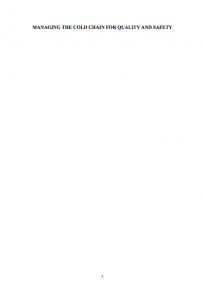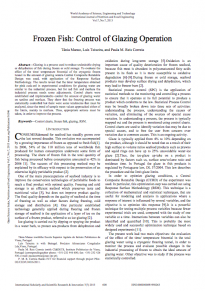Skills and Knowledge for Freezing
Key skills and knowledge required by those managing and working in a fish freezing facility and which prevent and reduce food loss and waste (FLW) include:
- principles of freezing and glazing
- packaging materials for frozen fishery products
- fish spoilage and raw material handling
- equipment for fish freezing
- cold chain principles
- cold storage operations
- GHP and GMP prerequisites
- Hazard analysis critical control point (HACCP)
Important ‘Do’s and Don’ts’
Important ‘Do’s and Don’ts’
The list below contains some of the most important ‘do’s and don’ts’ for both the chilled and frozen food producer:
- Maintain high levels of hygiene at all stages of the product’s life.
- Chill or freeze products quickly and adequately after preparation and manufacture.
- Rigidly maintain chill (<5°C) or frozen (<-18°C) temperatures, wherever possible, during storage and distribution.
- Rigidly maintain chill (<5°C) and frozen (<-18°C) temperatures in holding stores and display cabinets.
- Ensure that chilled or frozen products are transferred in a continuous operation (no stopping or delays) between temperature-controlled areas (e.g. delivery trucks to holding stores; storage areas to retail display units).
- Segregate cooked and uncooked chilled or frozen products in storage and retail display cabinets (e.g. segregate uncooked meats and ready-to-eat meat products).
- Conduct frequent and systematic temperature checks on chilled and frozen food product temperatures, using appropriate and calibrated instrumentation.
- Do not overload chilled or frozen retail cabinets with product: refer to cabinet manufacturer’s recommended capacity and loading patterns.
- Train and educate all personnel (including consumers) in the correct handling and storage of chilled and frozen foods. Re-educate when new practices are adopted.
Glazing
Glazing
According to the Code of Practice for Fish and Fishery Products, glazing is the application of a protective layer of ice formed at the surface of a frozen product by spraying it with, or dipping it into, clean seawater, potable water, or potable water with approved additives, as appropriate.
Glazing is a process used to reduce undesirable drying or dehydration of fish during frozen or cold storage. Excessive drying during frozen storage results in freezer burn and a decrease in fish quality.
Key Publications
Managing The Cold Chain For Quality And Safety This manual summarizes the key recommendations for processing, handling, distribution and storage of chilled and frozen foods. | |
Frozen Fish: Control of Glazing Operation Research on the implications of time/temperature on the glazing of fish. |
More Resources
More Resources
29 June 2024
27 February 2024
31 October 2023













